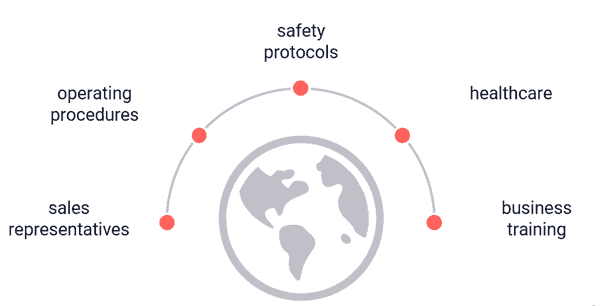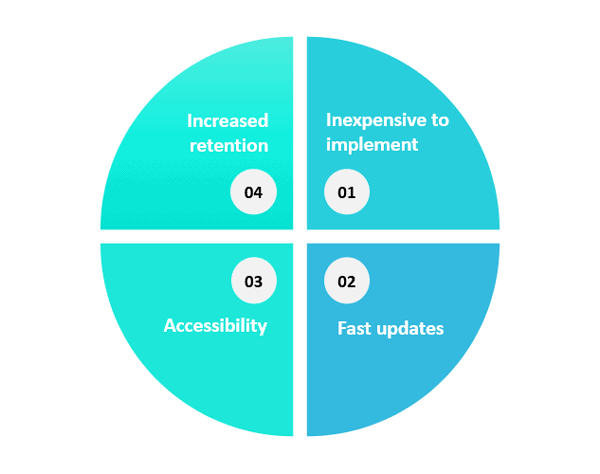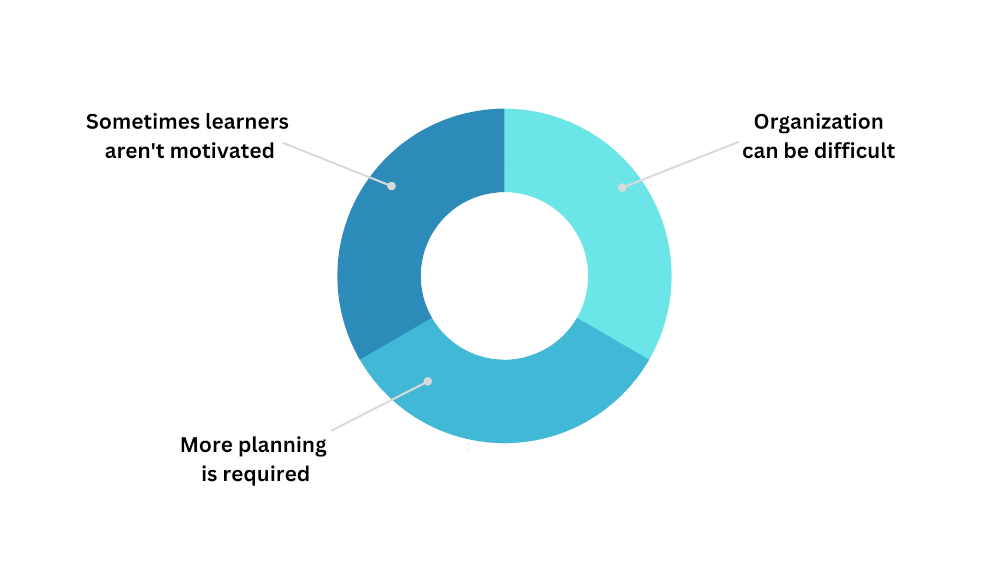Our content is reader supported, which means when you buy from links you click on, we may earn a commission.
What is Just-In-Time Learning? A Complete Guide to the Benefits & Overall Process

The world isn’t like what it used to be. In many cases, it took very little training before someone could take up their position in a company. However, technology innovation seeks to improve efficient work practices. Many companies have incorporated new technologies to streamline their operations. This includes work management software, portals for inventory, administration systems, and data collection and analysis software.
There is, however, a catch. The fast-paced development in technology hasn’t kept up with the workforce. Some skills can only be learned on the job. That’s because they are specialized in the business and custom-built as per the business model, hierarchy, procedures, and operations.
Companies had to invest in their employees upfront a couple of decades ago. But now, many companies expect employees to use just-in-time learning to get the job done.
What is Just-in-Time Learning?
The concept of just-in-time training, also known as just-in-time learning, is not new. It hasn’t had much traction over the years, considering it deviates from the conventional modes of acquiring education. That is to say, it relies on the philosophy that people in different roles do not need the same skill sets. As a result, they need not undergo the same training as a standard practice mode.
Thinking they might require certain skills in the future may waste time, effort, and resources. Hence, training them when the requirement comes along is a better approach. This is where just-in-time training comes in.
That’s gaining the knowledge you need, right when you need it for your job. But speaking generally, just-in-time learning can also be applied to anyone.
Knowledge is not something definitive. It keeps on growing and can expand on certain topics by intertwining with others. To attain complete or sufficient mastery of a subject, one needs to find connections between different fields. This may require learning some concepts to get a clear picture of your primary field. You may also require learning new tools and applications in a certain order. And once again, just-in-time training can help you get the knowledge you need right when needed.
It’s all about what you need to know at the moment. It gives you a chance to work on its application before reaching a bottleneck.
Examples of Just-in-Time Learning
The best way to explain just-in-time learning is to understand how it can be used. Here, we’ve compiled some examples to give you an idea of how it’s becoming more and more relevant.

Example 1: Updates for Sales Representatives
Sales representatives often need information on the go when dealing with both new and old customers. Depending on the industry they work in, they may require in-depth information at a moment’s notice. To use as an example, let’s say they are working in a brick-and-mortar store. With a plethora of products to sell, they need a repository of information in order to remain productive and sell in larger volumes. Plus, they need to be able to handle customer queries about their products that are often missing from product details.
Normally, sales representatives are given some information about the business, how it operates and what their market is. But in order to truly cater to customer needs, they need to go through catalogs. They also need some form of technical knowledge of the products they’re selling. Since this information is product-specific, just-in-time training is the perfect way to get it to them.
Example 2: Operating Procedures for Manual Workers
As mentioned before, not all companies follow the same operating procedures for certain jobs. They may be working in the same field, but that doesn’t mean they have to employ the same means to carry them out. This is particularly true for manual workers in the manufacturing and processing industries. They go through on-the-job training as their career progresses.
Manual tasks can only be learned as long as a person practices them. That’s because the people performing them need to adhere to a specific sequence of events to ensure the quality of work.
Let’s consider power plants, for example. There are a lot of maintenance regimes in place to keep the machinery running smoothly. Workers are trained to handle the operation and maintenance of new machinery when they’ve sufficiently learned to tackle the basic machines.
Additionally, industries evolve with time. They gain access to new machinery and tools that mechanize or automate previously labor-intensive tasks. Workers need instructions on how to use them if they don’t have any previous knowledge on how to use them. There’s really no option but to go towards just-in-time training in these scenarios.
Example 3: Safety Protocols
Safety is a major aspect of a workplace as a part of worker rights and metrics for performance. The exact protocols depend on the workplace’s work practices, tools, and machinery.
There’s no certain set of instructions that need to be followed, instead, it often requires dynamic assessments during work practices to mitigate or eliminate hazards. Coming back to our power plant example, workers need to be wary of the hazards on-site, as well as those they can encounter while sitting at their desks.
Some hazards are apparent, like high voltage lines, excessive temperatures, pressures, chemical poisoning, and even risks of radiation leaks. Others require safety training like fire risks, sitting ergonomically, what to do in case of encounters with vermin, and any temporary work hazards on site they should be aware of.
Regardless of the safety risks, workers need to be made aware of the consequences of doing work in an unsafe manner, its repercussions, and if they can lead to fatalities. Providing them training regarding safety rules followed on-site like what they need to look out for, how to report any hazards, and dealing with emergency scenarios, requires just-in-time training.
The more hazardous their job, the more stress should be placed on their training. Safety compliance is perhaps one of the most important aspects of any high-risk job. Companies may have to incur a number of penalties and fines after litigation proceedings in case of any severe safety, health, and environmental catastrophes.
Example 4: Healthcare
Healthcare is one of the most research-oriented professions in the world that mixes academia and real-world applications side by side. That’s why all aspects of just-in-time learning come into play here. On top of that, information isn’t readily available.
There aren’t many professionals working in the same fields, and pharmaceutical and medical research corporations don’t readily disclose information regarding their products. All of these translate down to the actual healthcare practice, creating a gap between innovative and previously accepted practices.
To bridge this gap, healthcare professionals may need to recreate studies, see their efficacy, and, if successful, provide instructions on how to implement them. These are then deployed to frontline workers and paramedical professionals.
The most recent example is Covid. As the Covid pandemic quickly took over the world, little was known about the mode of attack of the virus, how it spreads, and how fatal it was. It required training medical staff, as well as educating the public on ways to prevent the spread of the virus, ways of testing it, letting the public know which demographic is most susceptible to infection, and which vaccines are most effective against it.
In addition, doctors needed to assess which cases are legitimate based on the plethora and variation of symptoms, helping them determine the best course of action for treating the disease. Just-in-time training is perfect for handling all this during a pandemic.
Example 5: General Business and Marketing Training
Training employees is a process that often requires understanding the intricacies behind the business. As a result, insight can only be retained once an employee gets hands-on experience in the line of work they’re in. This aspect of learning especially comes into play when dealing with how a company approaches marketing. Marketing is a very diverse field with many factors and metrics that come into play.
Marketers must keep up with the different avenues they can explore to create product listings and get their companies message across to the target audience.
Not only this, but they also have to put measures in place to create brand awareness and gauge their existing brand image. All this knowledge cannot be compressed into a training program that lasts a few days. Instead, it requires just-in-time training for employees as the company continues to evolve.
Benefits of Just-in-Time Learning
Below are some of the benefits of establishing a just-in-time learning methodology.

- Inexpensive to Implement. Not everyone will need to undergo the same training depending on their responsibilities in an organization. Therefore, training everyone once on a mass scale requires considerable investment. That’s why training employees as per requirement is a much more inexpensive endeavor. Companies don’t need to maintain and invest in separate training departments if the skills employees need to learn at that point are readily available online at competitive rates.
- Fast Updates. Additionally, just-in-time learning is faster to implement compared to learning a big chunk at the beginning of your employees’ careers. It doesn’t require as much information to be absorbed before you can implement it. Therefore, it becomes easy to retain in one’s mind as one goes along with their path in their organization. More importantly, it builds upon existing knowledge. This way, you get to gain more knowledge in a shorter time if you accumulate the time for all training sessions.
- Accessibility. With the advent of learning portals and management systems, accessibility to training manuals and procedural documents has become easier than ever. This aspect of just-in-time training is especially helpful for people whose line of work involves a lot of fieldwork, especially when combined with mobile learning. When unsure about something, they can refer to their training manuals and easily return to their job.
- Increased Retention. The goal of just-in-time training is to increase performance. The problem with one-time training is that people tend to forget it and require refreshers after a while. But, by just-in-time learning, they are more likely to connect it with their previous knowledge base and implement it while on their job. The bottom line is better results, increased performance because they have a fresh understanding of how to implement their learning.
Disadvantages of Just-in-Time Training
Just like anything else, there are downsides to just-in-time learning. The following are the most common.

- Organization Can Be Difficult. Organizing content can be a daunting task. Finding the best way to present learning materials for just-in-time training can be a challenge. Learners need to be able to access content with ease, meaning proper organization is crucial. However, categorizing courses also has its obstacles when it comes to making them easily searchable.
- More Planning is Required. Crafting a just-in-time learning curriculum takes a significant amount of planning whether you’re developing an online course or teaching remotely. You’ll need to think carefully about the lessons required, creating efficient mini-lessons in 5 minutes or less, incorporating the topics, and disseminating them effectively.
- Sometimes Learners Aren’t Motivated. There’s a catch-22 when it comes to just-in-time learning. On one hand, it’s great when you don’t need someone to facilitate every lesson or everyone to coordinate schedules. However, the downside hits when students have to stay motivated and finish projects on their own, without anyone checking in. It’s definitely not for everyone.
How to Apply Just-in-Time Learning on The Job
You might wonder how to implement just-in-time learning at your workplace to substitute outdated training methodologies.
To start off, you need to identify job descriptions of the different employees in your workplace and gauge their current skill level. It may help to keep a list of the skills they possess. With this information in mind, you need to think of the other skills required to practice their job description efficiently.
Some topics are general, like organizational skills, communication, business lingo, and presentation skills. Others can be more specific to their work, like learning a programming language, data analytics, using proprietary software, etc.
Having a micro-learning resource library that contains course material on the skills above may be worth your while. Employees don’t have to waste time looking for resources independently and can access them on their mobile and desktop computers.
The Process of Creating Just-in-Time Learning
In order to implement a just-in-time learning program, you need to adhere to the following steps:

Step 1: Gather Information
You won’t be able to implement a just-in-time learning program without knowing what training is required. The best way to do this would be to figure out what is required. Talk to the relevant stakeholders like employees or potential clients. Gather their feedback on how they can develop their career and what skill the company would benefit from the most.
Step 2: Organization
Once you move toward establishing a just-in-time learning platform, you need to organize the learning information so that it becomes coherent to the learner and is systematically available to them.
Depending on the vastness of the resource library, you may need to invest in methodologies that make it easier for the learner to access relevant information on your portal or learning management system (LMS).
Chunking them up in a module may make it easier to digest. Or you can consider using categories to subdivide different skills. Just remember to keep training resources short and to the point to gain maximum utility from them. In most cases, a 3 to 5-minute video is enough to convey instructional information to the learner.
Step 3: Examples
Examples are the best ways to deliver new skills and knowledge. Seeing something in action and then applying it yourself makes a lasting impression. It also makes it easier to retain the information presented.
One way to go about this methodology is by keeping a learning objective in mind when creating learning resources. Make it clear to the learner what objective a specific learning resource fulfills. Then include real-world examples or work examples to drive home your point.
Tips on Making Just-in-Time Learning a Success
Here are a few tips to ensure your training leads to more success and less frustration for your learners.
- Figure out what you need. Before creating your training, you must figure out which content needs to be taught – it’s a crucial step to get started. Once you’ve determined the topics, curate the resources to begin the process.
- Leave some out. Trying to make all learning material available through JIT may not be the best option. Instead, focus on the most pertinent and essential topics useful in the JIT model, and create learning opportunities based on that. Consider what information fits well with this method while considering that trying to include all subjects is impractical.
- Group similar concepts together. Collect similar concepts and organize your topics accordingly. This not only increases the learning pace but also keeps the learners interested. An efficient just-in-time learning plan is critical to success.
- Chunk your learning. Just-in-time Learning is effective because it’s easily digestible. So rather than long and convoluted explanations, break information into bite-sized sections that include only the most vital bits.
- Provide examples and weave in relevant stories. Including examples and real-world stories are essential in making learning more interactive. Merely imparting information won’t cut it. Real-life scenarios pique learners’ interest and help them relate to the content. Learners will appreciate the relevance of the content if it is made practical in their life.
FAQs on Just-in-Time Learning
How is just-in-time learning implemented?
Just-in-time learning is a type of instruction closely aligned with the task that the learner will be performing. You can implement just-in-time learning in several ways.
For example, an organization may provide on-the-job training to new employees or create job aids that employees can consult when they need to perform a specific task.
Just-in-time learning is often seen as a more efficient and effective alternative to traditional forms of instruction, such as classroom-based training. It can also be more cost-effective since it eliminates the need for instructor-led training.
Who developed the just-in-time system?
The just-in-time system was developed in Japan by Toyota. The system was designed to cut down on waste and improve efficiency. The idea is that instead of stockpiling inventory, parts are only produced when needed. This allows for a leaner production process and helps to avoid costly delays.
Many other companies have adopted the just-in-time system, which has become an essential part of lean manufacturing. Thanks to the just-in-time system, factories can operate more efficiently and produce higher-quality products.